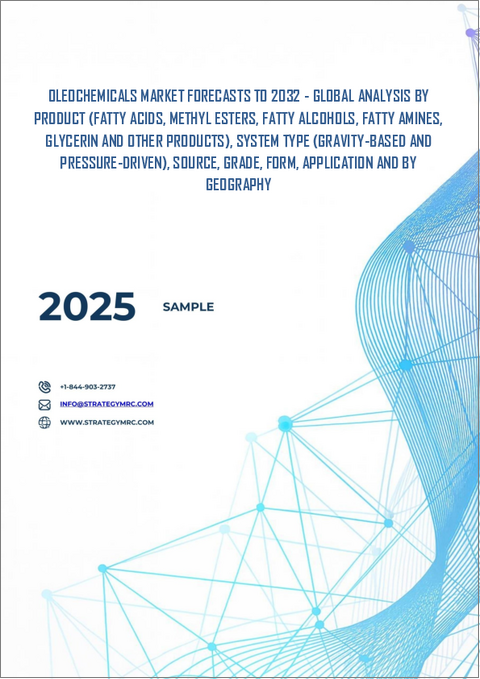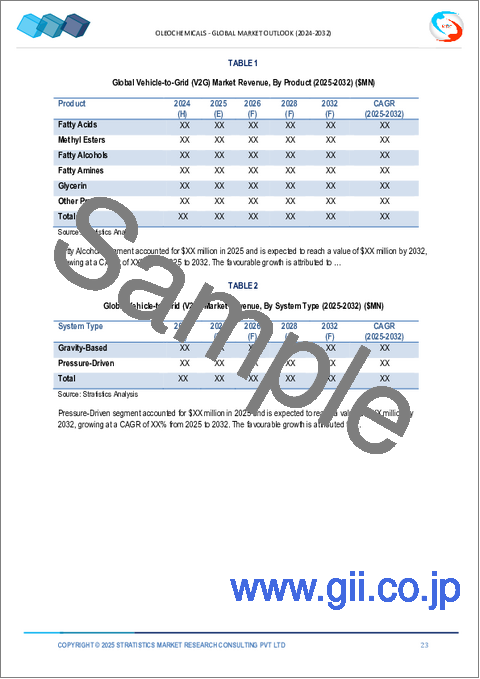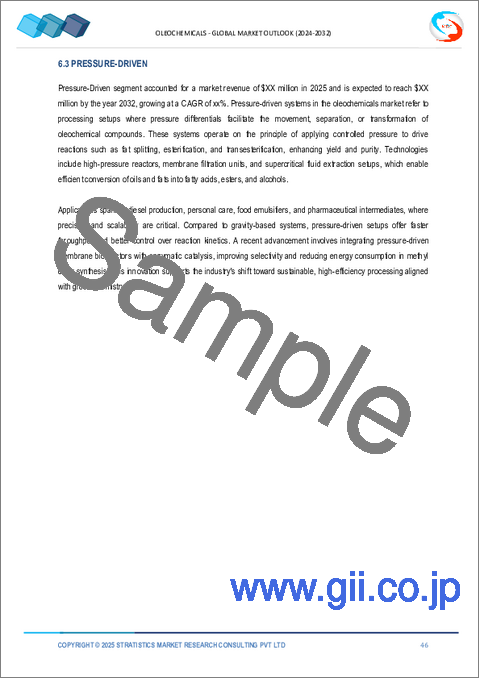|
|
市場調査レポート
商品コード
1603748
オレオケミカル市場の2030年までの予測: 製品別、システムタイプ別、供給源別、グレード別、形態別、用途別、地域別の世界分析Oleochemicals Market Forecasts to 2030 - Global Analysis By Product, System Type, Source, Grade, Form, Application and by Geography |
||||||
カスタマイズ可能
|
|||||||
| オレオケミカル市場の2030年までの予測: 製品別、システムタイプ別、供給源別、グレード別、形態別、用途別、地域別の世界分析 |
|
出版日: 2024年11月11日
発行: Stratistics Market Research Consulting
ページ情報: 英文 200+ Pages
納期: 2~3営業日
|
全表示
- 概要
- 図表
- 目次
Stratistics MRCによると、オレオケミカルの世界市場は2024年に271億2,000万米ドルを占め、予測期間中にCAGR 9.0%で成長し、2030年には454億8,000万米ドルに達する見込みです。
オレオケミカルは、通常植物や動物から得られる天然の油脂から作られるため、石油ベースの化学物質の持続可能な代替品です。さまざまな産業に不可欠なこれらの物質には、脂肪酸、グリセリン、脂肪アルコール、エステルが含まれます。さらに、これらの物質は石鹸、洗剤、化粧品、潤滑油、さらにはバイオ燃料のような商品の生産に不可欠であり、産業部門をより環境に優しく持続可能なものにするのに役立っています。
欧州化学物質庁(ECHA)によると、EUでは生分解性で持続可能な化学製品へと大きくシフトしており、オレオケミカルはその中でも特に注目されています。この動向の背景には、環境規制の強化や、環境に優しい製品を求める消費者の嗜好があります。
環境に優しい代替品への需要
オレオケミカル市場は、主に持続可能性への動向によって牽引されています。消費者の環境意識が高まるにつれ、化石燃料よりも再生可能な資源から作られた製品を選ぶ傾向が強まっています。この需要は、食品、パーソナルケア、産業用途など、多くの産業で見られます。環境意識の高い顧客にアピールするため、企業が商品を再利用してオレオケミカルを取り入れた結果、市場は拡大しています。
原料価格の変動
獣脂、大豆油、パーム油のようなオレオケミカル製造に不可欠な原料の価格は非常に不安定で、農業情勢の変化の影響を受けやすいです。天変地異、季節変動、天候パターンはすべて、作物の収量に大きな影響を及ぼし、結果として不足と価格上昇を招く。例えば、洪水や干ばつは、これらのエッセンシャルオイルの供給を激減させ、生産者のコストを上昇させる。さらに、貿易制限や関税のような地政学的要因によって価格変動がさらに悪化した場合、生産者が安定した価格と収益性を維持することは困難となります。
グリーンビルディングプロジェクトの増加
グリーンビルディングの台頭は、オレオケミカル市場に新たな大きな機会をもたらします。世界中の建築業界が持続可能性に高い優先順位を置いているため、環境に優しい塗料、接着剤、シーリング材、断熱製品へのニーズが高まっています。厳しい環境規制を満たす低排出建築材料は、オレオケミカルを使って作ることができます。さらに、オレオケミカルへの需要が高まる中、持続可能な建築慣行への動きは、建築物のエネルギー効率を高め、二酸化炭素排出量を削減するための国際的なイニシアチブを支えています。
石油化学代替品との競合
オレオケミカルの市場拡大は、確立された石油化学製品の代替品の存在によって深刻な脅威にさらされています。化石燃料から作られる合成化学品は、その確立されたサプライチェーンと低コストのため、長い間多くの産業で使用されてきました。そのため、製法や手順を変えたがらない企業にとって、オレオケミカルへの切り替えはリスクとみなされる可能性があります。さらに、合成化学の発展の結果、オレオケミカルの代替品よりもコスト効率が高かったり、性能が良かったりする新しい石油化学製品が開発される可能性もあります。
COVID-19の影響:
閉鎖、製造停止、輸送制限により、COVID-19の大流行はオレオケミカル市場に大きな影響を与え、さまざまな分野で混乱を引き起こしました。パンデミックの結果、特に食品やパーソナルケア製品に不可欠なグリセリンやバイオディーゼルの生産は当初減少しました。しかし、エコ製品や除菌剤、殺菌剤に対する消費者の関心が高まったことを主な理由として、景気が回復に向かうにつれ、オレオケミカルに対する需要は顕著に増加しました。さらに、パンデミックにより、産業界は石油化学製品に代わる生分解性の代替品を探すようになり、持続可能な慣行への移行が早まった。
パーム分野は予測期間中最大となる見込み
オレオケミカル市場は、パーム油分野で最大のシェアを占めると予想されます。脂肪酸と脂肪アルコールは、パーム油から作ることができる多くのオレオケミカル製品の一つであり、パーム油は収量が多く適応性が高いため貴重な原料です。インドネシアやマレーシアのような国々は、世界のパーム油の大部分を生産しており、合わせて全体のかなりの量を占めています。さらに、パーム油は入手しやすいため、油脂化学分野、特にアジア太平洋地域で主要な原料となっており、食品用途、石鹸、洗剤、パーソナルケア製品に広く使用されています。
パーソナルケア&化粧品分野は予測期間中最も高いCAGRが見込まれる
予測期間中、オレオケミカル市場のCAGRはパーソナルケアと化粧品分野で最も高いと予想されます。パーソナルケア処方における低刺激性で化学物質を含まない成分への需要の高まりと、消費者の天然・有機製品への嗜好の高まりが、この成長の主な原動力となっています。オレオケミカルは、その肌に優しい性質と生分解性から、植物や動物の脂肪のような再生可能な資源に由来し、クリーム、ローション、石鹸のような様々な化粧品にますます使用されるようになってきています。さらに、持続可能性や環境への配慮を求める消費者の動向を反映し、自然化粧品の世界市場は飛躍的に成長すると予想されています。
最大のシェアを持つ地域
オレオケミカル市場はアジア太平洋地域が支配的です。この優位性の主な理由は、この地域の生産能力の高さと、原料、特にマレーシアやインドネシアのような国から主に輸入されるパーム油やパーム核油の入手のしやすさにあります。これらの国々は、パーソナルケア、食品加工、産業製品など様々な用途に必要な脂肪酸やアルコールを大量に生産しているため、油脂化学産業の主要プレーヤーとなっています。さらに、この分野の市場は、産業界が環境に優しい代替品への移行を進めるにつれて、持続可能で生分解性のある製品に対する消費者の需要が高まっていることによって、さらに牽引されています。
CAGRが最も高い地域:
石油化学製品の代替品として生分解性製品の使用を奨励する規制が強化され、環境に優しく持続可能な製品に対する消費者の需要が高まっていることから、オレオケミカル市場のCAGRは欧州地域が最も高いと予想されます。オレオケミカルは、食品、パーソナルケア、産業用途で天然成分や有機成分を強く好む欧州市場のため、環境規制の遵守を求める生産者にとって望ましい選択肢です。さらに、ドイツ、フランス、オランダは、持続可能性と安全性規制を遵守する新しいオレオケミカル製品を作るために研究開発に多額の投資を行っており、このシフトの先頭に立っている国の一つです。
無料カスタマイズサービス:
本レポートをご購読のお客様には、以下の無料カスタマイズオプションのいずれかをご利用いただけます:
- 企業プロファイル
- 追加市場企業の包括的プロファイリング(3社まで)
- 主要企業のSWOT分析(3社まで)
- 地域セグメンテーション
- 顧客の関心に応じた主要国の市場推計・予測・CAGR(注:フィージビリティチェックによる)
- 競合ベンチマーキング
- 製品ポートフォリオ、地理的プレゼンス、戦略的提携に基づく主要企業のベンチマーキング
目次
第1章 エグゼクティブサマリー
第2章 序文
- 概要
- ステークホルダー
- 調査範囲
- 調査手法
- データマイニング
- データ分析
- データ検証
- 調査アプローチ
- 調査情報源
- 1次調査情報源
- 2次調査情報源
- 前提条件
第3章 市場動向分析
- 促進要因
- 抑制要因
- 機会
- 脅威
- 製品分析
- 用途分析
- 新興市場
- COVID-19の影響
第4章 ポーターのファイブフォース分析
- 供給企業の交渉力
- 買い手の交渉力
- 代替品の脅威
- 新規参入業者の脅威
- 競争企業間の敵対関係
第5章 世界のオレオケミカル市場:製品別
- 脂肪酸
- メチルエステル
- 脂肪アルコール
- 脂肪アミン
- グリセリン
- その他の製品タイプ
第6章 世界のオレオケミカル市場:システムタイプ別
- 重力ベース
- 圧力駆動
第7章 世界のオレオケミカル市場:供給源別
- パーム
- 大豆
- 菜種
- ひまわり
- 牛脂
- パームカーネル
- ココナッツ
- その他の供給源
第8章 世界のオレオケミカル市場:グレード別
- 製薬
- 食品
- 産業
- その他のグレード
第9章 世界のオレオケミカル市場:形態別
- 粉末
- フレーク
- 液体
- その他の形態
第10章 世界のオレオケミカル市場:用途別
- パーソナルケア・化粧品
- 消費財
- 食品・飲料
- 繊維
- 化学薬品
- 塗料・インク
- 産業
- ヘルスケア・医薬品
- ポリマー・プラスチック添加剤
- その他の用途
第11章 世界のオレオケミカル市場:地域別
- 北米
- 米国
- カナダ
- メキシコ
- 欧州
- ドイツ
- 英国
- イタリア
- フランス
- スペイン
- その他欧州
- アジア太平洋
- 日本
- 中国
- インド
- オーストラリア
- ニュージーランド
- 韓国
- その他アジア太平洋地域
- 南米
- アルゼンチン
- ブラジル
- チリ
- その他南米
- 中東・アフリカ
- サウジアラビア
- アラブ首長国連邦
- カタール
- 南アフリカ
- その他中東とアフリカ
第12章 主な発展
- 契約、パートナーシップ、コラボレーション、合弁事業
- 買収と合併
- 新製品発売
- 事業拡大
- その他の主要戦略
第13章 企業プロファイリング
- Evonik Industries AG
- Wilmar International Ltd.
- BASF SE
- Vantage Specialty Chemicals, Inc.
- Godrej Industries Limited
- SABIC
- Emery Oleochemicals Group
- JNJ Oleochemicals, Incorporated
- Sasol Limited
- Oleon N.V.
- Kao Chemicals Global
- Stepan Company
- Cargill Inc.
- P&G Chemicals
- Sulzer
List of Tables
- Table 1 Global Oleochemicals Market Outlook, By Region (2022-2030) ($MN)
- Table 2 Global Oleochemicals Market Outlook, By Product (2022-2030) ($MN)
- Table 3 Global Oleochemicals Market Outlook, By Fatty Acids (2022-2030) ($MN)
- Table 4 Global Oleochemicals Market Outlook, By Methyl Esters (2022-2030) ($MN)
- Table 5 Global Oleochemicals Market Outlook, By Fatty Alcohols (2022-2030) ($MN)
- Table 6 Global Oleochemicals Market Outlook, By Fatty Amines (2022-2030) ($MN)
- Table 7 Global Oleochemicals Market Outlook, By Glycerin (2022-2030) ($MN)
- Table 8 Global Oleochemicals Market Outlook, By Other Products (2022-2030) ($MN)
- Table 9 Global Oleochemicals Market Outlook, By System Type (2022-2030) ($MN)
- Table 10 Global Oleochemicals Market Outlook, By Gravity-Based (2022-2030) ($MN)
- Table 11 Global Oleochemicals Market Outlook, By Pressure-Driven (2022-2030) ($MN)
- Table 12 Global Oleochemicals Market Outlook, By Source (2022-2030) ($MN)
- Table 13 Global Oleochemicals Market Outlook, By Palm (2022-2030) ($MN)
- Table 14 Global Oleochemicals Market Outlook, By Soy (2022-2030) ($MN)
- Table 15 Global Oleochemicals Market Outlook, By Rapeseed (2022-2030) ($MN)
- Table 16 Global Oleochemicals Market Outlook, By Sunflower (2022-2030) ($MN)
- Table 17 Global Oleochemicals Market Outlook, By Tallow (2022-2030) ($MN)
- Table 18 Global Oleochemicals Market Outlook, By Palm Kernel (2022-2030) ($MN)
- Table 19 Global Oleochemicals Market Outlook, By Coconut (2022-2030) ($MN)
- Table 20 Global Oleochemicals Market Outlook, By Other Sources (2022-2030) ($MN)
- Table 21 Global Oleochemicals Market Outlook, By Grade (2022-2030) ($MN)
- Table 22 Global Oleochemicals Market Outlook, By Pharma (2022-2030) ($MN)
- Table 23 Global Oleochemicals Market Outlook, By Food (2022-2030) ($MN)
- Table 24 Global Oleochemicals Market Outlook, By Industrial (2022-2030) ($MN)
- Table 25 Global Oleochemicals Market Outlook, By Other Grades (2022-2030) ($MN)
- Table 26 Global Oleochemicals Market Outlook, By Form (2022-2030) ($MN)
- Table 27 Global Oleochemicals Market Outlook, By Powder (2022-2030) ($MN)
- Table 28 Global Oleochemicals Market Outlook, By Flakes (2022-2030) ($MN)
- Table 29 Global Oleochemicals Market Outlook, By Liquid (2022-2030) ($MN)
- Table 30 Global Oleochemicals Market Outlook, By Other Forms (2022-2030) ($MN)
- Table 31 Global Oleochemicals Market Outlook, By Application (2022-2030) ($MN)
- Table 32 Global Oleochemicals Market Outlook, By Personal Care & Cosmetics (2022-2030) ($MN)
- Table 33 Global Oleochemicals Market Outlook, By Consumer Goods (2022-2030) ($MN)
- Table 34 Global Oleochemicals Market Outlook, By Food & Beverages (2022-2030) ($MN)
- Table 35 Global Oleochemicals Market Outlook, By Textiles (2022-2030) ($MN)
- Table 36 Global Oleochemicals Market Outlook, By Chemicals (2022-2030) ($MN)
- Table 37 Global Oleochemicals Market Outlook, By Paints & Inks (2022-2030) ($MN)
- Table 38 Global Oleochemicals Market Outlook, By Industrial (2022-2030) ($MN)
- Table 39 Global Oleochemicals Market Outlook, By Healthcare & Pharmaceuticals (2022-2030) ($MN)
- Table 40 Global Oleochemicals Market Outlook, By Polymer & Plastic Additives (2022-2030) ($MN)
- Table 41 Global Oleochemicals Market Outlook, By Other Applications (2022-2030) ($MN)
Note: Tables for North America, Europe, APAC, South America, and Middle East & Africa Regions are also represented in the same manner as above.
According to Stratistics MRC, the Global Oleochemicals Market is accounted for $27.12 billion in 2024 and is expected to reach $45.48 billion by 2030 growing at a CAGR of 9.0% during the forecast period. Oleochemicals are sustainable substitutes for petroleum-based chemicals because they are made from natural oils and fats, which are usually obtained from plants and animals. These substances, which are vital to many different industries, include fatty acids, glycerin, fatty alcohols, and esters. Moreover, they are essential to the production of goods like soaps, detergents, cosmetics, lubricants, and even bio fuels, which helps to make the industrial sector greener and more sustainable.
According to the European Chemicals Agency (ECHA), the European Union has seen a significant shift towards biodegradable and sustainable chemical products, with oleochemicals being a major focus. This trend is driven by stricter environmental regulations and consumer preferences for eco-friendly products.
Market Dynamics:
Driver:
Demand for eco-friendly substitutes
The market for oleochemicals is being driven primarily by the trend toward sustainability. Consumers are increasingly choosing products made from renewable resources over fossil fuels as they become more environmentally conscious. This demand can be seen in a number of industries, such as food, personal care, and industrial applications. The market is expanding as a result of businesses repurposing their goods to incorporate oleochemicals in an effort to appeal to environmentally conscious customers.
Restraint:
Price volatility for raw materials
The cost of essential raw materials for the production of oleochemicals, like tallow, soybean oil, and palm oil, is extremely erratic and susceptible to changes in agricultural conditions. Natural catastrophes, seasonal fluctuations and weather patterns can all have a significant effect on crop yields, resulting in shortages and price increases. For instance, floods or droughts can drastically cut down on the supply of these essential oils, which would increase the cost to producers. Furthermore, it can be difficult for producers to maintain stable pricing and profitability when price volatility is further exacerbated by geopolitical factors like trade restrictions and tariffs.
Opportunity:
Increase in green building projects
The emergence of green building practices presents the oleochemicals market with yet another significant opportunity. There is a growing need for environmentally friendly paints, adhesives, sealants, and insulation products as the building industry around the world places a higher priority on sustainability. Low-emission construction materials that satisfy strict environmental regulations can be made using oleochemicals. Additionally, with increasing demand for oleochemicals, this move toward sustainable building practices supports international initiatives to raise building energy efficiency and lower carbon footprints.
Threat:
Competition from alternatives to petrochemicals
The market expansion for oleochemicals is seriously threatened by the existence of well-established petrochemical substitutes. Because of their established supply chains and lower costs, synthetic chemicals made from fossil fuels have long been used by many industries. For businesses that are reluctant to alter their formulations or procedures, switching to oleochemicals may therefore be viewed as a risk. Furthermore, new petrochemical products that are more cost-effective or perform better than oleochemicals alternatives may be developed as a result of developments in synthetic chemistry.
Covid-19 Impact:
Due to lockdowns, manufacturing halts, and transportation restrictions, the COVID-19 pandemic had a major impact on the oleochemical market and caused disruptions in a number of different sectors. Production initially decreased as a result of the pandemic, especially for glycerin and biodiesel, which are essential for food and personal care products. The demand for oleochemicals did, however, noticeably increase as economies started to recover, primarily due to growing consumer interest in eco-friendly products, sanitizers, and disinfectants. Moreover, the pandemic caused industries to look for biodegradable substitutes for petrochemicals, hastening the transition to sustainable practices.
The Palm segment is expected to be the largest during the forecast period
The oleochemicals market is expected to have the largest share in the palm oil segment. Fatty acids and fatty alcohols are among the many oleochemical products that can be made from palm oil, which is a valuable raw material because of its high yield and adaptability. Countries like Indonesia and Malaysia produce the majority of the world's palm oil, which together makes up a sizeable amount of the total. Additionally, palm oil's accessibility has made it a leading feedstock in the oleochemical sector, especially in the Asia-Pacific area, where it finds widespread use in food applications, soaps, detergents, and personal care products.
The Personal Care & Cosmetics segment is expected to have the highest CAGR during the forecast period
Over the course of the forecast period, the oleochemicals market's highest CAGR is anticipated in the personal care and cosmetics segment. The growing demand for hypoallergenic and chemical-free ingredients in personal care formulations, along with consumers growing preference for natural and organic products, is the main drivers of this growth. Because of their skin-friendly qualities and biodegradability, oleochemicals, which come from renewable sources like plant and animal fats, are being used more and more in a range of cosmetic products like creams, lotions, and soaps. Furthermore, it is anticipated that the global market for natural cosmetics will grow dramatically, reflecting a larger consumer trend toward sustainability and environmental consciousness.
Region with largest share:
The oleochemical market is dominated by the Asia-Pacific region. The main reasons for this dominance are the region's significant production capacity and the accessibility of raw materials, especially palm oil and palm kernel oil, which are mostly imported from nations like Malaysia and Indonesia. Because they produce large amounts of fatty acids and alcohols that are necessary for a variety of applications, such as personal care, food processing, and industrial products, these countries are major players in the oleochemical industry. Moreover, the market in this area is further driven by the rising consumer demand for sustainable and biodegradable products as industries move more and more toward environmentally friendly substitutes.
Region with highest CAGR:
Due to stricter regulations encouraging the use of biodegradable substitutes for petrochemicals and rising consumer demand for eco-friendly and sustainable products, the Europe region is expected to have the highest CAGR in the oleochemicals market. Oleochemicals are a desirable alternative for producers looking to adhere to environmental regulations because of the European market's strong preference for natural and organic ingredients in food, personal care, and industrial applications. Furthermore, Germany, France, and the Netherlands are among the nations spearheading this shift, making significant investments in R&D to create novel oleochemical products that adhere to sustainability and safety regulations.
Key players in the market
Some of the key players in Oleochemicals market include Evonik Industries AG, Wilmar International Ltd., BASF SE, Vantage Specialty Chemicals, Inc., Godrej Industries Limited, SABIC, Emery Oleochemicals Group, JNJ Oleochemicals, Incorporated, Sasol Limited, Oleon N.V., Kao Chemicals Global, Stepan Company, Cargill Inc., P&G Chemicals and Sulzer.
Key Developments:
In August 2024, SABIC, a global leader in diversified chemicals signed a potential investment agreement with the Fujian government, under the auspices of the Saudi Ministry of Energy, to build an engineering thermoplastics compounding plant in China's Fujian Province.
In July 2024, BASF and ENGIE signed a 7-year Biomethane Purchase Agreement (BPA). Under the BPA, ENGIE will supply BASF with 2.7 to 3.0 terawatt hours of biomethane throughout the term of the agreement. BASF uses certified biomethane at its Ludwigshafen/Germany and Antwerp/Belgium sites as a sustainable alternative to fossil raw materials in its manufacturing process.
In March 2024, Evonik Vland Biotech, a new joint venture between Evonik China and Shandong Vland Biotech, began operations. The venture aims to expand the market presence of their livestock probiotics in Greater China and develop new products.
Products Covered:
- Fatty Acids
- Methyl Esters
- Fatty Alcohols
- Fatty Amines
- Glycerin
- Other Products
System Types Covered:
- Gravity-Based
- Pressure-Driven
Sources Covered:
- Palm
- Soy
- Rapeseed
- Sunflower
- Tallow
- Palm Kernel
- Coconut
- Other Sources
Grades Covered:
- Pharma
- Food
- Industrial
- Other Grades
Forms Covered:
- Powder
- Flakes
- Liquid
- Other Forms
Applications Covered:
- Personal Care & Cosmetics
- Consumer Goods
- Food & Beverages
- Textiles
- Chemicals
- Paints & Inks
- Industrial
- Healthcare & Pharmaceuticals
- Polymer & Plastic Additives
- Other Applications
Regions Covered:
- North America
- US
- Canada
- Mexico
- Europe
- Germany
- UK
- Italy
- France
- Spain
- Rest of Europe
- Asia Pacific
- Japan
- China
- India
- Australia
- New Zealand
- South Korea
- Rest of Asia Pacific
- South America
- Argentina
- Brazil
- Chile
- Rest of South America
- Middle East & Africa
- Saudi Arabia
- UAE
- Qatar
- South Africa
- Rest of Middle East & Africa
What our report offers:
- Market share assessments for the regional and country-level segments
- Strategic recommendations for the new entrants
- Covers Market data for the years 2022, 2023, 2024, 2026, and 2030
- Market Trends (Drivers, Constraints, Opportunities, Threats, Challenges, Investment Opportunities, and recommendations)
- Strategic recommendations in key business segments based on the market estimations
- Competitive landscaping mapping the key common trends
- Company profiling with detailed strategies, financials, and recent developments
- Supply chain trends mapping the latest technological advancements
Free Customization Offerings:
All the customers of this report will be entitled to receive one of the following free customization options:
- Company Profiling
- Comprehensive profiling of additional market players (up to 3)
- SWOT Analysis of key players (up to 3)
- Regional Segmentation
- Market estimations, Forecasts and CAGR of any prominent country as per the client's interest (Note: Depends on feasibility check)
- Competitive Benchmarking
- Benchmarking of key players based on product portfolio, geographical presence, and strategic alliances
Table of Contents
1 Executive Summary
2 Preface
- 2.1 Abstract
- 2.2 Stake Holders
- 2.3 Research Scope
- 2.4 Research Methodology
- 2.4.1 Data Mining
- 2.4.2 Data Analysis
- 2.4.3 Data Validation
- 2.4.4 Research Approach
- 2.5 Research Sources
- 2.5.1 Primary Research Sources
- 2.5.2 Secondary Research Sources
- 2.5.3 Assumptions
3 Market Trend Analysis
- 3.1 Introduction
- 3.2 Drivers
- 3.3 Restraints
- 3.4 Opportunities
- 3.5 Threats
- 3.6 Product Analysis
- 3.7 Application Analysis
- 3.8 Emerging Markets
- 3.9 Impact of Covid-19
4 Porters Five Force Analysis
- 4.1 Bargaining power of suppliers
- 4.2 Bargaining power of buyers
- 4.3 Threat of substitutes
- 4.4 Threat of new entrants
- 4.5 Competitive rivalry
5 Global Oleochemicals Market, By Product
- 5.1 Introduction
- 5.2 Fatty Acids
- 5.3 Methyl Esters
- 5.4 Fatty Alcohols
- 5.5 Fatty Amines
- 5.6 Glycerin
- 5.7 Other Products
6 Global Oleochemicals Market, By System Type
- 6.1 Introduction
- 6.2 Gravity-Based
- 6.3 Pressure-Driven
7 Global Oleochemicals Market, By Source
- 7.1 Introduction
- 7.2 Palm
- 7.3 Soy
- 7.4 Rapeseed
- 7.5 Sunflower
- 7.6 Tallow
- 7.7 Palm Kernel
- 7.8 Coconut
- 7.9 Other Sources
8 Global Oleochemicals Market, By Grade
- 8.1 Introduction
- 8.2 Pharma
- 8.3 Food
- 8.4 Industrial
- 8.5 Other Grades
9 Global Oleochemicals Market, By Form
- 9.1 Introduction
- 9.2 Powder
- 9.3 Flakes
- 9.4 Liquid
- 9.5 Other Forms
10 Global Oleochemicals Market, By Application
- 10.1 Introduction
- 10.2 Personal Care & Cosmetics
- 10.3 Consumer Goods
- 10.4 Food & Beverages
- 10.5 Textiles
- 10.6 Chemicals
- 10.7 Paints & Inks
- 10.8 Industrial
- 10.9 Healthcare & Pharmaceuticals
- 10.10 Polymer & Plastic Additives
- 10.11 Other Applications
11 Global Oleochemicals Market, By Geography
- 11.1 Introduction
- 11.2 North America
- 11.2.1 US
- 11.2.2 Canada
- 11.2.3 Mexico
- 11.3 Europe
- 11.3.1 Germany
- 11.3.2 UK
- 11.3.3 Italy
- 11.3.4 France
- 11.3.5 Spain
- 11.3.6 Rest of Europe
- 11.4 Asia Pacific
- 11.4.1 Japan
- 11.4.2 China
- 11.4.3 India
- 11.4.4 Australia
- 11.4.5 New Zealand
- 11.4.6 South Korea
- 11.4.7 Rest of Asia Pacific
- 11.5 South America
- 11.5.1 Argentina
- 11.5.2 Brazil
- 11.5.3 Chile
- 11.5.4 Rest of South America
- 11.6 Middle East & Africa
- 11.6.1 Saudi Arabia
- 11.6.2 UAE
- 11.6.3 Qatar
- 11.6.4 South Africa
- 11.6.5 Rest of Middle East & Africa
12 Key Developments
- 12.1 Agreements, Partnerships, Collaborations and Joint Ventures
- 12.2 Acquisitions & Mergers
- 12.3 New Product Launch
- 12.4 Expansions
- 12.5 Other Key Strategies
13 Company Profiling
- 13.1 Evonik Industries AG
- 13.2 Wilmar International Ltd.
- 13.3 BASF SE
- 13.4 Vantage Specialty Chemicals, Inc.
- 13.5 Godrej Industries Limited
- 13.6 SABIC
- 13.7 Emery Oleochemicals Group
- 13.8 JNJ Oleochemicals, Incorporated
- 13.9 Sasol Limited
- 13.10 Oleon N.V.
- 13.11 Kao Chemicals Global
- 13.12 Stepan Company
- 13.13 Cargill Inc.
- 13.14 P&G Chemicals
- 13.15 Sulzer






